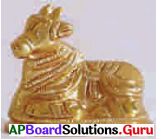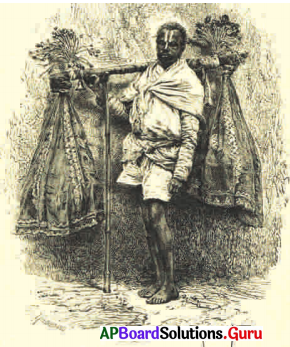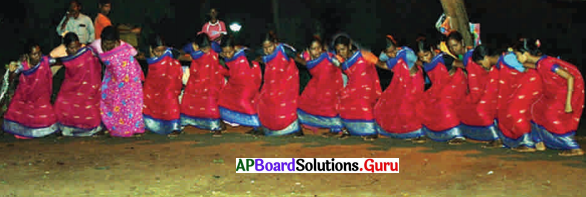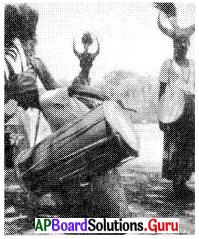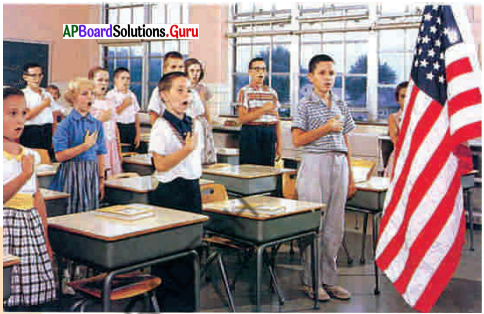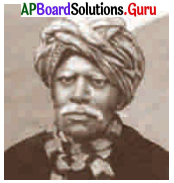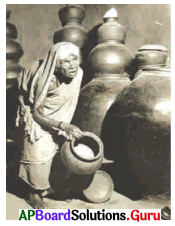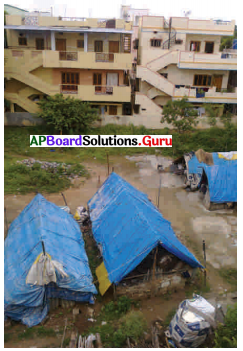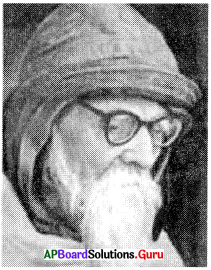Practice the AP 9th Class Social Bits with Answers Chapter 1 Our Earth on a regular basis so that you can attempt exams with utmost confidence.
AP State Syllabus 9th Class Social Bits 1st Lesson Our Earth with Answers
Choose the correct answer.
Question 1.
Which of the following is not an environmental crisis?
A) Global warming
B) Air pollution
C) Collision of asteroids
D) The rise of water levels in oceans
Answer:
C) Collision of asteroids
Question 2.
Which of the following is the biggest of all?
A) Galaxies
B) Milky way
C) Sun
D) Universe
Answer:
D) Universe
![]()
Question 3.
The universe started ……………… ago.
A) 18.7 billion years
B) 13.7 billion years
C) 16.7 billion years
D) 15.7 billion years
Answer:
B) 13.7 billion years
Question 4.
……………… is the path of the earth around the sun.
A) The axis
B) The orbit
C) The tract
D) The milky way
Answer:
B) The orbit
Question 5.
Earth travels around the sun at a speed of …………….. per hour.
A) 1,07,200 kms
B) 6,200 kms
C) 152 millions kms
D) 1,02,700 kms
Answer:
A) 1,07,200 kms
Question 6.
Earth takes ………………. days to complete one revolution.
A) 28 days
B) 30 days
C) 366 days
D) 365[latex]\frac{1}{4}[/latex] days
Answer:
D) 365[latex]\frac{1}{4}[/latex] days
![]()
Question 7.
Which of the following causes seasons on the earth?
A) Daily rotation of the earth on its axis
B) Monthly movement of the Moon around the Earth
C) Revolution of the Earth around the Sun
D) Tilt of Earth’s axis of rotation to its orbital plane
Answer:
D) Tilt of Earth’s axis of rotation to its orbital plane
Question 8.
The Earth began to form around years ago.
A) 13.7 billion
B) 1,07,200
C) 4[latex]\frac{1}{2}[/latex] billion
D) 6 billion
Answer:
C) 4[latex]\frac{1}{2}[/latex] billion
Question 9.
Which of the following came into existence first?
A) Human beings
B) Plants
C) Animals
D) Ocean species
Answer:
D) Ocean species
Question 10.
The radius of the earth is ………….
A) 1,07,200 kms
B) 9000 kms
C) 8848 kms
D) 6000 kms
Answer:
D) 6000 kms
Question 11.
Top layer of the earth is called
A) Crust
B) Mantle
C) Outer core
D) None of these
Answer:
A) Crust
![]()
Question 12.
Which of the following layers of the earth is very thin?
A) Crust
B) Mantle
C) Outer core
D) Inner core
Answer:
A) Crust
Question 13.
Which of the following layers is the thickest?
A) Outer core
B) Mantle
C) Crust
D) None of these
Answer:
A) Outer core
Question 14.
Which of the following layers consists of silicons?
A) Outer core
B) Mantle
C) Crust
D) Inner core
Answer:
B) Mantle
Question 15.
Which of the following layers consists of iron and nickel?
A) Crust
B) Mantle
C) Outer core
D) None of these
Answer:
C) Outer core
![]()
Question 16.
Which of the following layers consists of gold?
A) Crust
B) Mantle
C) Inner core
D) Outer core
Answer:
C) Inner core
Question 17.
Who introduced the theory of continental drift?
A) Alfred Nobel
B) Alfred Wagener
C) John Dalton
D) Galileo Galilei
Answer:
B) Alfred Wagener
Question 18.
We can locate places on the earth with the help of
A) latitudes
B) longitudes
C) grid
D) equator
Answer:
C) grid
Question 19.
Latitudes are
A) circles
B) straight lines
C) semi-circles
D) curves
Answer:
A) circles
![]()
Question 20.
Longitudes are
A) circles
B) semi-circles
C) straight lines
D) curves
Answer:
B) semi-circles
Question 21.
Which latitude is called Tropic of Cancer?
A) 0° latitude
B) 23[latex]\frac{1}{2}[/latex]° South latitude
C) 23[latex]\frac{1}{2}[/latex]° North latitude
D) 66[latex]\frac{1}{2}[/latex]° North latitude
Answer:
C) 23[latex]\frac{1}{2}[/latex]° North latitude
Question 22.
Which latitude is called Tropic of
A) 23[latex]\frac{1}{2}[/latex]° South latitude
B) 66[latex]\frac{1}{2}[/latex]° North latitude
C) 66[latex]\frac{1}{2}[/latex]° South latitude
D) 0° latitude
Answer:
A) 23[latex]\frac{1}{2}[/latex]° South latitude
Question 23.
0° meridian is called
A) Greenwich meridian
B) Anti-meridian
C) UTC
D) Equator
Answer:
A) Greenwich meridian
Question 24.
180° meridian is called
A) Greenwich meridian
B) Anti-meridian
C) UTC
D) Equator
Answer:
B) Anti-meridian
![]()
Question 25.
How much time does the earth take to move 1° longitude?
A) 24 hours
B) one hour
C) 4 minutes
D) 4 hours
Answer:
C) 4 minutes
Question 26.
The earth is divided into
A) 36
B) 24
C) 30
D) 60
Answer:
B) 24
Question 27.
Standard meridian of India is
A) 0° longitude
B) 82° 30′ Eastern longitude
C) 82° 30′ Western latitude
D) 90° Eastern longitude
Answer:
B) 82° 30′ Eastern longitude
Question 28.
The Indian standard time is
A) 12 hours before Greenwich time
B) 12 hours after Greenwich time
C) 5[latex]\frac{1}{2}[/latex]° hours before Greenwich time
D) 5[latex]\frac{1}{2}[/latex]° hours after Greenwich time
Answer:
C) 5[latex]\frac{1}{2}[/latex]° hours before Greenwich time
![]()
Question 29.
Universe started some …………… billion years ago.
A) One Lakh
B) 472
C) 152
D) 13.7
Answer:
D) 13.7
Question 30.
Earth travels around the sun at a speed of ………….. kmph.
A) 2,07,100
B) 7,02,100
C) 1,07,200
D) 1,02,700
Answer:
C) 1,07,200
Question 31.
Human beings arrived on earth ………….. years ago.
A) 10,00,000
B) 1,00,000
C) 1 crore
D) 1 billion
Answer:
B) 1,00,000
Question 32.
First life appeared on planet Earth in
A) oceans
B) plants
C) animals
D) plains
Answer:
A) oceans
![]()
Question 33.
Heavy substance gold most prevalent in
A) Crust
B) Mantle
C) Outer core
D) Inner core
Answer:
D) Inner core
Question 34.
Alfred Wagener a geophysicist of
A) Italy
B) Austria
C) France
D) Germany
Answer:
D) Germany
Question 35.
The largest latitude is
A) North pole
B) Arctic circle
C) Equator
D) Tropic of cancer
Answer:
C) Equator
Question 36.
………….. longitude is Standard Meridian of India.
A) 83°20’E
B) 82°30’E
C) 83°20’W
D) 82°30’W
Answer:
B) 82°30’E
![]()
Question 37.
The world is divided in …………. time zones.
A) four
B) twenty four
C) twelve
D) eight
Answer:
B) twenty four
Question 38.
Earth’s farthest point from Sun is ………. km.
A) 152 mn
B) 125 mn
C) 174 mn
D) 147 mn
Answer:
A) 152 mn
Question 39.
Earth’s closest point from Sun is ………… km.
A) 147 mn
B) 174 mn
C) 125 mn
D) 152 mn
Answer:
A) 147 mn
Question 40.
Earth takes day(s) to complete a rotation.
A) 365[latex]\frac{1}{4}[/latex]
B) 1
C) 30
D) 31
Answer:
B) 1
![]()
Question 41.
The shape of the orbit is ……….
A) a circular path
B) an elongated oval path
C) a scaled oval path
D) a triangular path
Answer:
C) a scaled oval path
Question 42.
…………. is the cause of the formation of seasons on earth.
A) Rotation of the earth
B) Revolution of the earth
C) Tilt of earth’s axis
D) Shape of earth.
Answer:
B) Revolution of the earth
Question 43.
………… is the top most layer of the earth.
A) Crust
B) Core
C) Mantle
D) Centre
Answer:
A) Crust
Question 44.
……………… proposed continental drift theory.
A) Newton
B) Darwin
C) Wagener
D) Alexander
Answer:
C) Wagener
Question 45.
The super continent is …………
A) Panthalsa
B) Pangaea
C) Tethys
D) Laurasia
Answer:
A) Panthalsa
![]()
Question 46.
The network of latitudes and longitudes is …………
A) atlas
B) map
C) grid
D) equator
Answer:
C) grid
Question 47.
0° longitude is known as
A) Prime Meridian
B) Equator
C) Tropics
D) International Date Line
Answer:
A) Prime Meridian
Question 48.
The width of each time zone is …………. longitudes.
A) 10° of longitudes
B) 5° of longitudes
C) 15° of longitudes
D) 20° of longitudes
Answer:
C) 15° of longitudes
Question 49.
Let us look at the internal structure of the Earth we live on. We can see the continuity from the early days of the formation of the earth as we try to look deep inside the Earth! It took us years of scientific investigation and analysis of data to form an understanding of the interior of the Earth. The main reason for this is that even the deepest mines we have dug do not go beyond a few kilometres under the surface white the radius or the distance to the centre of the earth is over 6000 kilometres!
Read the paragraph and answer the question.
The radius of the earth is
A) 5000 kms
B) 6000 kms
C) 7000 kms
D) 8000 kms
Answer:
B) 6000 kms
![]()
Question 50.
Look at the pictures of the Earth, Sun and the orbit given below. Which one do you think is the correct picture?
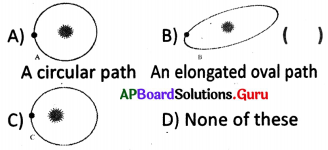
Answer:
C)
Question 51.
See the picture and answer the following questions.
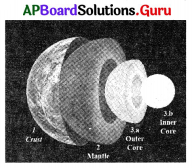
i) The depth of the crust is
A) 20 – 80 kms
B) 30 – 100 kms
C) 40 – 100 kms
D) 50 – 100 kms
Answer:
B) 30 – 100 kms
ii) The thickness of the mantle is
A) 100 – 1000 kms
B) 200 – 2000 kms
C) 100 – 2900 kms
D) 200 – 3900 kms
Answer:
C) 100 – 2900 kms
iii) The depth of the core is
A) 2,500 – 5,500 kms
B) 4,500 – 8,000 kms
C) 2,900 – 6,376 kms
D) 5,000 – 9,000 kms
Answer:
C) 2,900 – 6,376 kms
![]()
iv) The core is divided into
A) 2 sub layers
B) 3 sub layers
C) different parts
D) none of the above
Answer:
A) 2 sub layers
v) Which layer is supposed to have more gold?
A) Crust
B) Mantle
C) Core
D) Inner core
Answer:
D) Inner core
vi) Which is the uppermost layer of the earth?
A) Mantle
B) Crust
C) Outer core
D) Inner core
Answer:
B) Crust
vii) Silicates are in
A) Core
B) Crust
C) Mantle
D) None of the above
Answer:
C) Mantle
![]()
viii) Ferrous is in
A) Outer core
B) Inner core
C) Mantle
D) Crust
Answer:
A) Outer core
Question 52.
Observe the picture and answer the questions.

i) The latitudinal value of Equator is
A) 90°
B) 180°
C) 360°
D) 0°
Answer:
D) 0°
ii) In which hemisphere is the Arctic circle situated?
A) Southern
B) Northern
C) Eastern
D) Western
Answer:
B) Northern
iii) 90° North and South latitudes are called
A) Meridians
B) Parallels
C) Poles
D) Circles
Answer:
C) Poles
![]()
iv) 23[latex]\frac{1}{2}[/latex]°N latitude is also called as
A) Arctic circle
B) Tropic of cancer
C) Tropic of capricorn
D) Antarctic circle
Answer:
B) Tropic of cancer
v) The value of North pole is
A) 66°
B) 66[latex]\frac{1}{2}[/latex]°
C) 23°
D) 90°
Answer:
D) 90°
vi) The Southern and Northern Hemispheres are divided by
A) Greenwich
B) Equator
C) Tropic of cancer
D) Tropic of capricorn
Answer:
B) Equator
Question 53.
Observe the pictures and answer the questions given below.

i) “Whole land” as having existed in ………….. million years ago.
A) 600
B) 500
C) 200
D) 220
Answer:
D) 220
![]()
ii) Continental drift theory was introduced by
A) Aristotle
B) Alfred Wagener
C) Plato
D) Galileo
Answer:
B) Alfred Wagener
iii) Pangaea means
A) Whole land
B) Ocean
C) Mountain
D) River
Answer:
A) Whole land
iv) Panthalassa means
A) Whole land
B) Ocean
C) Hill
D) Canyon
Answer:
B) Ocean
v) Pangaea is divided into ………… parts.
A) Three
B) Four
C) Two
D) Five
Answer:
C) Two
vi) Laurensia and Gondwana lands were divided by
A) Arabian Sea
B) Bay of Bengal
C) Tethys Sea
D) Indian Ocean
Answer:
C) Tethys Sea
![]()
Question 54.
When it is 12 noon in Greenwich (0)°, what is the time in India?
A) 5.30 pm
B) 5.00 pm
C) 4.30 pm
D) 6.00 pm
Answer:
A) 5.30 pm
Question 55.
If it is 12.00 hours at midnight of Sunday at Greenwich, the time in India is
A) 5.30 am on Monday
B) 5.30 am on Sunday
C) 6.30 pm on Sunday
D) 6.30 am on Monday
Answer:
A) 5.30 am on Monday
Observe the map and answer questions 56 & 57.
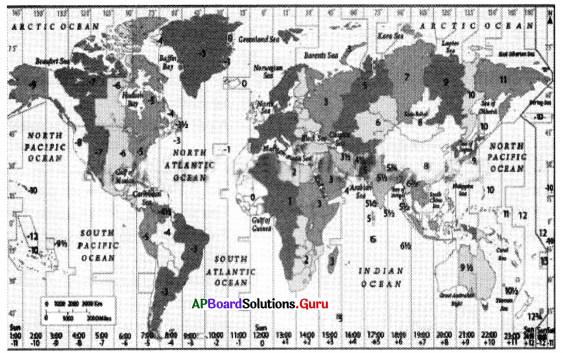
Question 56.
If you travel from New Delhi to Paris to which time zone are you moving?
A) 0°
B) 10°
C) 20°
D) 30°
Answer:
A) 0°
![]()
Question 57.
If you are traveling from Hyderabad to Tokyo which time zone are you moving?
A) 9 – 10 time zone
B) 1 – 2 time zone
C) 4 – 5 time zone
D) 3 – 4 time zone
Answer:
A) 9 – 10 time zone
Match the following:
Question 58.
Group – A Group – B
1) Equator ( ) A) 90° North latitude
2) Tropic of Cancer ( ) B) 0° North latitude
3) Tropic of Capricorn ( ) C) 90° South latitude
4) Northern Pole ( ) D) 23[latex]\frac{1}{2}[/latex]° South latitude
5) Southern Pole ( ) E) 23[latex]\frac{1}{2}[/latex]° North latitude
Answer:
1) B
2) E
3) D
4) A
5) C
Question 59.
Group – A Group – B
1) Parallels ( ) A) 0° longitude
2) Meridians ( ) B) 180° longitude
3) Greenwich meridian ( ) C) Latitudes
4) Anti-meridian ( ) D) 82° 30′ East longitude
5) Indian standard meridian ( ) E) Longitudes
Answer:
1) C
2) E
3) A
4) B
5) D
![]()
Question 60.
Group – A Group – B
1) Radius of earth ( ) A) 13.7 billion years ago
2) No.of longitudes ( ) B) 180
3) No.of latitudes ( ) C) 1,07,200 kms
4) Speed of earth round the sun ( ) D) 6000 kms
5) Birth of universe ( ) E) 360
Answer:
1) D
2) E
3) B
4) C
5) A
Question 61.
Group – A Group – B
1) Latitudes ( ) A) Nearly circular
2) Longitudes ( ) B) Circles
3) Orbit ( ) C) Universal time co-ordinated
4) Grid ( ) D) Semi-circles
5) UTC ( ) E) A pattern of square on a map
Answer:
1) B
2) D
3) A
4) E
5) C
Question 62.
Group – A Group – B
1) Big Bang ( ) A) The northern break up part of Pangaea
2) Laurensia ( ) B) The sourthern break up part of Pangaea
3) Pangaea ( ) C) The single large explosion that created the universe
4) Tethys ( ) D) The massive super continent that existed 220 million years ago
5) Gondwana ( ) E) A long shallow inland sea that separated Laurensia and Gondwana
Answer:
1) C
2) A
3) D
4) E
5) B
![]()
Question 63.
The world is divided into 24 time zones. Number of longitudes in each one are ………….
A) 10
B) 15
C) 20
D) 25
Answer:
B) 15
Question 64.
The exact time difference between Greenwich and IST is
A) +5 Hours
B) -5 Hours
C) +5[latex]\frac{1}{2}[/latex] Hours
D) -5[latex]\frac{1}{2}[/latex] Hours
Answer:
C) +5[latex]\frac{1}{2}[/latex] Hours
Question 65.
The longitude taken as Indian Standard Time is:
A) 23[latex]\frac{1}{2}[/latex]° N
B) 82[latex]\frac{1}{2}[/latex]° E
C) 23[latex]\frac{1}{2}[/latex]° S
D) 82[latex]\frac{1}{2}[/latex]° W
Answer:
B) 82[latex]\frac{1}{2}[/latex]° E
Question 66.
Most of the life on Earth is:
A) On the floor
B) In the air
C) Under the water
D) In the space
Answer:
A) On the floor
![]()
Question 67.
Total number of longitudes
A) 180
B) 120
C) 360
D) 0
Answer:
C) 360
Examine given map and answer the question 68 and 69.
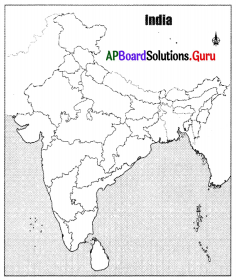
Question 68.
Indian standard time (Longitude) passes through from which of the following.
A) Mumbai
B) Alahabad
C) Bangalore
D) Ahmedabad
Answer:
B) Alahabad
Question 69.
Tropic of cancer passes through from which of the following.
A) Gujarath
B) Kerala
C) Karnataka
D) Jammu & Kashmir
Answer:
A) Gujarath
Question 70.
The number of longitudes in a time zone
A) 12
B) 15
C) 18
D) 20
Answer:
B) 15
Question 71.
The percentage of Earth Crust in the volume of the earth
A) 83%
B) 16%
C) 1%
D) 42%
Answer:
C) 1%
![]()
Question 72.
India is located within the …………… and the ………….. hemispheres?
A) Eastern and Western
B) Northern and Southern
C) Eastern and Northern
D) Southern and Eastern
Answer:
C) Eastern and Northern
Question 73.
Which of the following statements is true?
A) Stars can live for millions of years.
B) All stars are part of our solar system.
C) Stars appear in the same place in the sky every night.
D) All stars are of the same size.
Answer:
B) All stars are part of our solar system.
Answer questions 74 and 75 based on the map given below.
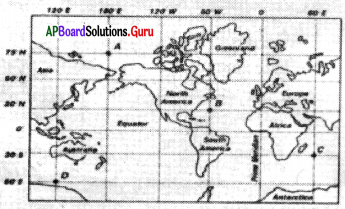
Question 74.
A ship is at point C in the map. What is the exact position of the ship?
A) 60°W and 60° E
B) 60°W and 30° E
C) 60° E and 30° S
D) 60° E and 60° S
Answer:
C) 60° E and 30° S
Question 75.
What is the difference in degrees, between points B and D in the map ?
A) 30°
B) 60°
C) 120°
D) 180°
Answer:
C) 120°
![]()
Question 76.
Which of the following continent completely lies in the Northern hemisphere.
A) Australia
B) South America
C) Asia
D) Europe
Answer:
D) Europe
Question 77.
Which number on the image forms the crust of the Earth?
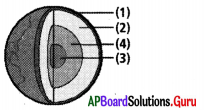
A) 1
B) 2
C) 3
D) 4
Answer:
A) 1
Question 78.
In the Atlas, the location of Agra is shown like this;

What information about Agra does the circled part denotes?
A) Page Number
B) Latitude
C) Longitude
D) Altitude
Answer:
C) Longitude
Question 79.
The latest technology that has been used to know the latitudes and longitudes of a place is:
A) Atlas
B) Compass
C) Google Earth
D) Map
Answer:
C) Google Earth
![]()
Question 80.
“Unless we exploit the natural resources, development is not at all possible:
A) Though it is unjust, it is the fact only.
B) This is unjust and unreal too. Development is possible without destroying the nature also.
C) Development is first. Everything including environment is next.
D) This opinion is unjust.
Answer:
A) Though it is unjust, it is the fact only.
Instruction: Observe below Map and answer 81 to 87 questions:
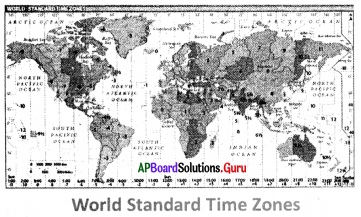
Question 81.
Which country has ‘0’ time zone:
A) Srilanka
B) USA
C) England
D) India
Answer:
C) England
Question 82.
How many time zones the world is divided?
A) 12
B) 15
C) 360
D) 24
Answer:
D) 24
Question 83.
Which time zone India lies in?
A) 5[latex]\frac{1}{2}[/latex]
B) -5[latex]\frac{1}{2}[/latex]
C) -5
D) 5
Answer:
A) 5[latex]\frac{1}{2}[/latex]
![]()
Question 84.
If 2.00 pm in London, what is the time in Delhi, the capital of India?
A) 12:00 pm
B) 7.30 pm
C) 2.00 pm
D) 7:30 am
Answer:
B) 7.30 pm
Question 85.
South Africa lies in which time zone?
A) 6
B) 1
C) 5
D) 2
Answer:
D) 2
Question 86.
Why some countries has more that one time zone?
A) In this countries so many languages are in use.
B) Many climatic conditions.
C) These countries has many Governments.
D) These countries lies among many longitudes.
Answer:
D) These countries lies among many longitudes.
Question 87.
What is the base to calculate time in a country?
A) Longitudes
B) Equator
C) Tropic of cancer
D) Latitudes
Answer:
A) Longitudes
![]()
Question 88.
Consider the following statements ‘A’ and ‘B’ and find out which of them is/ are true. During the last hundred years people have understood that:
A. Stars are born an they grow.
B. They even dies.
A) A is false, B is true.
B) A is true and B is also true.
C) A is false and B is also false.
D) A is true, B is false.
Answer:
B) A is true and B is also true.
Question 89.
In the depth of 150 kms from the surface, the layer of the Earth consists
A) Silicates
B) Liquid metallic material like Nickel and Iron
C) Heavy substances like Gold
D) Various kinds of rocks
Answer:
A) Silicates
Question 90.
Rani has a Globe. Among the following which can’t she know about a place with the help of that globe?
A) In which direction should we go to reach it?
B) How much the cost of living would be there?
C) What time it would be there at any moment?
D) How hot or cold it would be there?
Answer:
A) In which direction should we go to reach it?
Question 91.
Consider the following statements and choose the correct one among the options given below.
A. Though several countries tries to fix a longitude that passes through their own territory as the 0° longitude, the Greenwich longitude was accepted as the 0° longitude.
B. England ruled a large part of the world at that time.
A) Both A and B are true. A was a reson to make B possible.
B) Both A and B are true. There is no relation between A and B.
C) Only A is true. There is no relation between A and B.
D) Both A and B are true. B was a reason to make A possible.
Answer:
B) Both A and B are true. There is no relation between A and B.
![]()
Question 92.
Which of the following is not part of Gondwana?
A) Africa
B) Australia
C) India
D) North America
Answer:
D) North America
Question 93.
Find out the wrongly shown latitude among the following
A) 66[latex]\frac{1}{2}[/latex]° N
B) 0°S
C) 66[latex]\frac{1}{2}[/latex]° S
D) 23[latex]\frac{1}{2}[/latex]° N
Answer:
B) 0°S
Question 94.
Location of Delhi:
A) 28.7°N, 77.1°E
B) 28.7°S, 77.1°W
C) 28.7°E, 77.1°W
D) 28.7°E, 77.1°N
Answer:
A) 28.7°N, 77.1°E
Question 95.
All of us live on the Earth. Related to Earth, which among the following statements is not true?
A) Half of the Earth’s history remained lifeless.
B) The Earth has reached its present form through several phases.
C) Now the Earth has reached a fixed stage that doesn’t go through any change.
D) The Earth is made up of three main layers.
Answer:
C) Now the Earth has reached a fixed stage that doesn’t go through any change.
![]()
The location of a few cities is shown on the map given below. Read the map carefully to answer questions 96 and 97.
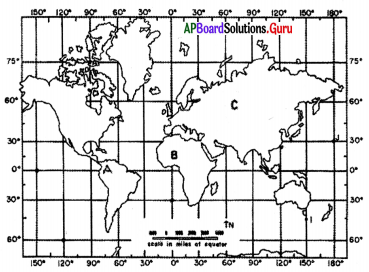
Question 96.
Which of the following cities is located 60 degrees north and 60 degrees East?
A) City A
B) City B
C) City C
D) City D
Answer:
C) City C
Question 97.
When it is 12 Noon at Greenwich meridian (0), What will be the local time at CITY ‘C’?
A) 4 AM
B) 4 PM
C) 2 AM
D) 2 PM
Answer:
B) 4 PM
